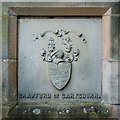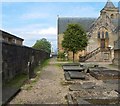The picture was taken from Campbell Street.
Image is at the extreme right. For another view of the church, see
Image For the inscription on the near side of the building, see
Image
As is noted on that inscription, a kirk was built in Greenock by Sir John Schaw / Shaw in 1591 (the kirk that now stands here is clearly much more recent, but it incorporates parts of the earlier Old West Kirks).
It was in 1589 that a royal charter by James VI granted Shaw permission to separate a portion from the parish of Inverkip in order to form the parish of Greenock; it also granted him permission "on his awin coist to Erect and big one parroche kirk vpoun his awin heretage"; the kirk was to be for the benefit of the poor people of "Grenok fynnartie and spangok" (Greenock, Finnart, and Spango), specifically, for "the puir pepill duelling vpoun his lands and heretage qlkis ar all fischers and of a ressounable nowmer duelland four myles fra thair parroche kirk" ["qlkis": quhilkis = which; "duelland": dwelling].
[The charter describes the poor who were living on Shaw's lands and heritage as fishers (there were then small fishing communities in what is now Greenock). They were said to be living four miles from their parish kirk, i.e., the existing one, at Inverkip.]
This charter was ratified by the Scottish Parliament in 1592. For those who are comfortable with the language (Middle Scots), much of the text of the charter (which also describes the difficulties the poor of Greenock faced in reaching the parish kirk at Inverkip, especially in winter) is reproduced in Daniel Weir's "History of the Town of Greenock" (1829).
The church and manse were finished in 1591, and there was an adjoining kirkyard by 1592; this first Old West Kirk was at a different site:
Image /
Image
Writing in the early nineteenth century, Weir notes that the church had largely been rebuilt about 70 years earlier, and that "the oldest gravestone bears the date 1675". Gravestones with that date can still be seen beside the present-day church building (see
Image), where they have been incorporated into the north-western wall of the kirkyard:
Image and
Image A corbel stone bearing the date 1625 has also been built into that wall:
Image
[For a feature, probably from the mid-eighteenth century, that is built into the wall of the church building itself, see
Image]
After Weir's time, there were to be further changes. By the 1830s, the church had been in use for over two centuries, and was in very poor condition. As Robert Murray Smith notes in his "History of Greenock" (1921), "the kirk was said then to be most uncomfortable and unhealthy. The churchyard was so filled up that the earth outside was two feet above the level of the floor, and in rainy weather it was necessary to place boards to enable the people to step in at the doors". He adds that, as it was expressed at the time, the congregation were "just sitting over a pool of liquid mud".
That building was condemned in 1837, and a move was made to a church on a new site in 1841. However, the church on the original site was rebuilt in 1864, and it was this building that was later moved in its entirety: in 1926, it was rebuilt in its present location, using as much of the material of the 1864 building as was practical. The building that was finished in 1926 is the present-day Old West Kirk, the one that is shown in this photograph. See http://portal.historic-scotland.gov.uk/designation/LB34095 (at Historic Environment Scotland) for its listed building report, which expands upon some of these details.
A few of the memorials were moved along with the church; others were relocated to a site within Greenock Cemetery:
Image










